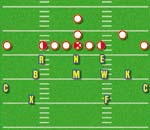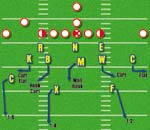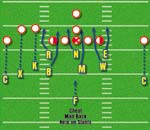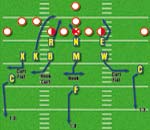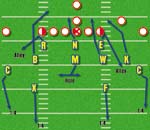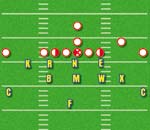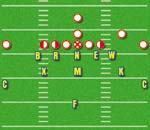Article CategoriesAFM Magazine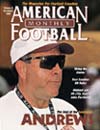
|
Voodoo MagicFighting the spreadby: Rob Cushman Head coach, Eastern Oregon © More from this issue TODAY'S SPREAD ATTACKS require defenses to be extremely flexible. Nowhere in the country is a defense more challenged by the spread then here in the Northwest. On a typical Saturday, we see three, four and even five wideouts stretching the field sideline-to-sideline while quarterbacks and receivers play pitch and catch at least 50 times a game. A defense must also contend with strong running games. A one- or two-back scheme, the inside zone, stretch or counter, power lead and even the option are all runs we have to deal with. If you overload to stop one phase of the attack, you leave yourself vulnerable to something else. Often, defenses find themselves straying from their regular packages to play some form of nickel or dime scheme to defend spread personnel. Many times, defenses aren't comfortable with this type of approach because they haven't spent enough time practicing it and getting the correct personnel on the field is a problem. Sometimes they try to simplify their approach and find themselves unable to attack the way they would like. They truly become defensive. Because we face these challenges eight or nine times a year, we experimented with several ideas and schemes that we could incorporate into one complete package. Since the mid-1990s, we have been playing a three down linemen, five defensive back package we call the Voodoo. It allows us the flexibility to be a six-, seven-or eight-man front, bring tremendous pressure from various angles while still being able to have multiple coverage. The Voodoo gives us a base package that is very different from conventional fronts and requires offenses to rethink their blocking rules and protections which can lead to confusion. From an alignment standpoint, we have the ability to handle multiple formations. The theory of the Voodoo is simple - we stack inside, attack inside out and bend on blocks, causing everything to spill outside so we can run to the football. One key to the package is our extra defender, generally a DB. This scheme allows us to place our extra DB (K) wherever he is most needed - to help with the run on the LOS, to support from the secondary, to be a deep defender, an underneath defender, a man-cover player or on the blitz. We have the ability to run several different zone blitzes as well. Probably the greatest asset of this package is that it allows us to get from one front, pressure or cover, to another very quickly without making complicated changes that negate our aggressiveness and without substituting personnel. BEAVER The base look is shown in Diagram 1. We call this scheme the Beaver. Our strong end [R] is in a 7, the nose (N) is shaded strong and the weak end (E) is in a 5. The MLB (M) is head up on the center. The strong OLB (B) is stacked outside of R, virtually headed up on the TE and the weak OLB (W) is stacked behind E. With a Beaver call, the extra DB (K) goes to the threat or "most receivers" side. It is important to note that K, X secondary is aligned based on coverage called either man or zone. Versus the balanced set shown (Diagram 1) we are a balanced defense with 5 1/2 defenders to each side of the formation. If the offense becomes unbalanced, we make simple adjustments to compensate. We also can tag the call - Beaver "Eye." This moves the E to a weak 41 and W must adjust slightly outside. Basic Gap Resp: Versus 2 TE, we generally mirror both sides, however some weeks we make a game plan adjustment or check. Diagram 2 shows a possible zone coverage from Beaver. Diagram 3 shows a possible pressure with man-coverage from Beaver. Diagram 4 shows a zone coverage from a pressure look from Beaver. Diagram 5 shows a zone blitz from Beaver. STUD The next look we play is called the Stud (Diagram 6). With a Stud call, K aligns to TE. Putting K on the LOS gives us an additional edge defender and allows us to move the defensive line which may confuse our opponent. From this position, K can support, drop or attack. Because they're stacked, this front allows our best LBs to be very aggressive and fly to the ball. This becomes a seven-man front, and if we drop a safety down, we can play an eight-man front as well. Once again, we must line up the secondary properly to compensate for the movement of K and the front. We generally go into a game with only two or three coverages with this front. Gap Resp: Versus 2 TE, we generally adjust our strong safety (X) to mirror the additional TE. TOUGH The next look we can show is called Tough (Diagram 7). A Tough call puts B and W on the LOS in a quick pressure position. It also moves our N to a 0 alignment and our ends into a 41 alignment, which we have found to give offenses some problems. This is a seven-man front that incorporates the safeties as well. The secondary is more involved in inside run support, especially to the TE side. As always, K has specific rules by front. In Tough, K must align to threat and therefore is more of a pass defender. We generally only play this in certain down and distance situations, or if our opponent is having trouble getting everyone blocked. Offenses tend to throw against this alignment, but again we can mix coverages, however we are somewhat limited. If we drop F down, we can show an eight-man front. Gap Resp: Versus 2 TE, W adjusts on his TE to mirror B - plays read force with a DB. |
|
| HOME |
MAGAZINE |
SUBSCRIBE | ONLINE COLUMNISTS | COACHING VIDEOS |
Copyright 2024, AmericanFootballMonthly.com
All Rights Reserved


